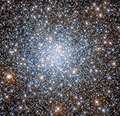ملف:NGC6638 - HST - Potw2231a.jpg

حجم هذه المعاينة: 622 × 599 بكسل. الأبعاد الأخرى: 249 × 240 بكسل | 498 × 480 بكسل | 797 × 768 بكسل | 1٬063 × 1٬024 بكسل | 2٬125 × 2٬048 بكسل | 2٬611 × 2٬516 بكسل.
الملف الأصلي (2٬611 × 2٬516 بكسل حجم الملف: 3٫35 ميجابايت، نوع MIME: image/jpeg)
تاريخ الملف
اضغط على زمن/تاريخ لرؤية الملف كما بدا في هذا الزمن.
| زمن/تاريخ | صورة مصغرة | الأبعاد | مستخدم | تعليق | |
|---|---|---|---|---|---|
| حالي | 19:53، 1 أغسطس 2022 |  | 2٬611 × 2٬516 (3٫35 ميجابايت) | Fabian RRRR | == {{int:filedesc}} == {{Information |description={{en|1='''Star-Studded Skyfield This star-studded image from the NASA/ESA Hubble Space Telescope shows the heart of the globular cluster NGC 6638 in the constellation Sagittarius. The star-strewn observation highlights the density of stars at the heart of globular clusters, which are stable, tightly bound clusters of tens of thousands to millions of stars. To capture the data in this image, Hubble used two of its cutting-edge astronomical in... |
استخدام الملف
الصفحة التالية تستخدم هذا الملف:
الاستخدام العالمي للملف
الويكيات الأخرى التالية تستخدم هذا الملف:
- الاستخدام في ce.wikipedia.org
- الاستخدام في de.wikipedia.org
- الاستخدام في diq.wikipedia.org
- الاستخدام في en.wikipedia.org
- الاستخدام في eo.wikipedia.org
- الاستخدام في es.wikipedia.org
- الاستخدام في eu.wikipedia.org
- الاستخدام في fr.wikipedia.org
- الاستخدام في nl.wikipedia.org
- الاستخدام في tt.wikipedia.org
- الاستخدام في www.wikidata.org


